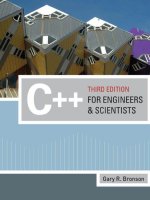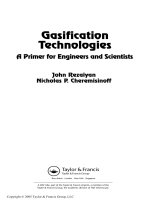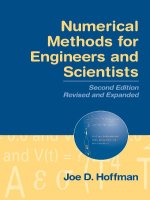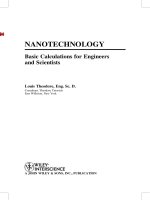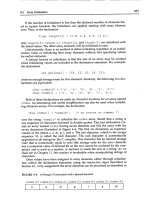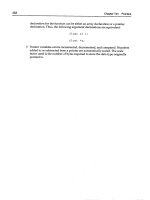numerical methods for engineers and scientists
Bạn đang xem bản rút gọn của tài liệu. Xem và tải ngay bản đầy đủ của tài liệu tại đây (33.62 MB, 835 trang )
Numerical
Methods for
Engineers and
Scientists
Numerical
Methods for
Engineers and
Scientists
Second Edition
Revised and Expanded
Joe D. Hoffman
Department of Mechanical Engineering
Purdue University
West Lafayette, Indiana
MARCEL
DEKKER
MARCEL DEKKER, INC.
NEW YORK. BASEL
The first edition of this book was published by McGraw-Hill, Inc. (New York, 1992).
ISBN: 0-8247-0443-6
This book is printed on acid-free paper.
Headquarters
Marcel Dekker, Inc.
270 Madison Avenue, blew York, NY 10016
tel: 212-696-9000; fax: 212-685-4540
Eastern Hemisphere Distribution
Marcel Dekker AG
Hutgasse 4, Postfach 812, CH-4001 Basel, Switzerland
tel: 41-61-261-8482; fax: 41-61-261-8896
World Wide Web
The publisher offers discounts on this book when ordered in bulk quantities. For more information,
write to Special Sales/’Professional Marketing at the headquarters address above.
Copyright © 2001 by Marcel Dekker, Inc. All Rights Reserved.
Neither this book nor any part may be reproduced or transmitted in any form or by any means,
electronic or mechanical, including photocopying, microfilming, and recording, or by any informa-
tion storage and retrieval system, without permission in writing from the publisher.
Current printing (last digit)
10987654321
PRINTED IN THE UNITED STATES OF AMERICA
To Cynthia Louise Hoffman
Preface
The second edition of this book contains several major improvements over the first edition.
Some of these improvements involve format and presentation philosophy, and some of the
changes involve old material which has been deleted and new material which has been
added.
Each chapter begins with a chapter table of contents. The first figure carries a sketch
of the application used as the example problem in the chapter. Section 1 of each chapter is
an introduction to the chapter, which discusses the example application, the general subject
matter of the chapter, special features, and solution approaches. The objectives of the
chapter are presented, and the organization of the chapter is illustrated pictorially. Each
chapter ends with a summary section, which presents a list of recommendations, dos and
don’ts, and a list of what you should be able to do after studying the chapter. This list is
actually an itemization of what the student should have learned from the chapter. It serves
as a list of objectives, a study guide, and a review guide for the chapter.
Chapter 0, Introduction, has been added to give a thorough introduction to the book
and to present several fundamental concepts of relevance to the entire book.
Chapters 1 to 6, which comprise Part I, Basic Tools of Numerical Analysis, have
been expanded to include more approaches for solving problems. Discussions of pitfalls of
selected algorithms have been added where appropriate. Part I is suitable for second-
semester sophomores or first-semester juniors through beginning graduate students.
Chapters 7 and 8, which comprise Part II, Ordinary Differential Equations, have
been rewritten to get to the methods for solving problems more quickly, with less emphasis
on theory. A new section presenting extrapolation methods has been added in Chapter 7.
All of the material has been rewritten to flow more smoothly with less repetition and less
theoretical background. Part II is suitable for juniors through graduate students.
Chapters 9 to 15 of the first edition, which comprised Part III, Partial Differential
Equations, has been shortened considerably to only four chapters in the present edition.
Chapter 9 introduces elliptic partial differential equations. Chapter 10 introduces parabolic
partial differential equations, and Chapter 11 introduces hyperbolic partial differential
equations. These three chapters are a major condensation of the material in Part III of the
first edition. The material has been revised to flow more smoothly with less emphasis on
theoretical background. A new chapter, Chapter 12, The Finite Element Method, has been
added to present an introduction to that important method of solving differential equations.
A new section, Programs, has been added to each chapter. This section presents
several FORTRAN programs for implementing the algorithms developed in each chapter
to solve the example application for that chapter. The application subroutines are written in
vi
Preface
a form similar to pseudocode to facilitate the implementation of the algorithms in other
programming languages.
More examples and more problems have been added throughout the book.
The overall objective of the second edition is to improve the presentation format and
material content of the first edition in a manner that not only maintains but enhances the
usefullness and ease of use of the first edition.
Many people have contributed to the writing of this book. All of the people
acknowledged in the Preface to the First Edition are again acknowledged, especially my
loving wife, Cynthia Louise Hoffman. My many graduate students provided much help
and feedback, especially Drs. D. Hofer, R. Harwood, R. Moore, and R. Stwalley. Thanks,
guys. All of the figures were prepared by Mr. Mark Bass. Thanks, Mark. Once again, my
expert word processing specialist, Ms. Janice Napier, devoted herself unsparingly to this
second edition. Thank you, Janice. Finally, I would like to acknowledge my colleague, Mr.
B. J. Clark, Executive Acquisitions Editor at Marcel Dekker, Inc., for his encouragement
and support during the preparation of both editions of this book.
Joe D. Hoffman
Contents
Preface
Chapter 0.
0.1.
0.2.
0.3.
0.4.
0.5.
0.6.
0.7.
0.8.
Part I.
1.1.
1.2.
1.3.
1.4.
1.5.
1.6.
1.7.
Introduction
Objectives and Approach
Organization of the Book
Examples
Programs
Problems
Significant Digits, Precision, Accuracy, Errors, and Number Representation
Software Packages and Libraries
The Taylor Series and the Taylor Polynomial
Basic Tools of Numerical Analysis
Systems of Linear Algebraic Equations
Eigenproblems
Roots of Nonlinear Equations
Polynomial Approximation and Interpolation
Numerical Differentiation and Difference Formulas
Numerical Integration
Summary
Chapter 1. Systems of Linear Algebraic Equations
1.1. Introduction
1.2. Properties of Matrices and Determinants
1.3. Direct Elimination Methods
1.4. LU Factorization
1.5.
Tridiagonal Systems of Equations
1.6.
Pitfalls of Elimination Methods
1.7. Iterative Methods
1.8. Programs
1.9. Summary
Exercise Problems
Chapter 2. Eigenproblems
2.1. Introduction
2.2. Mathematical Characteristics of Eigenproblems
2.3. The Power Method
V
1
1
2
2
3
3
4
6
7
11
11
13
14
14
15
16
16
17
18
21
30
45
49
52
59
67
76
77
81
81
85
89
vii
viii
2.4.
The Direct Method
2.5. The QR Method
2.6. Eigenvectors
2.7. Other Methods
2.8. Programs
2.9. Summary ,
Exercise Problem
Chapter 3. Nonlinear E
3.1. Introduction
3.2. General Features
3.3.
Closed Domain (1
3.4.
Open Domain M~
3.5.
Polynomials
3.6. Pitfalls of Root F
3.7. Systems of Nonli~
3.8. Programs
3.9. Summary
Exercise Problem.,
uations
Root Finding
~racketing) Methods
Ihods
nding Methods and Other Methods of Root Finding
~ear Equations
Chapter 4. Polynomial ~pproximation and Interpolation
4.1. Introduction
4.2.
Properties of Pol’ aomials
4.3. Direct Fit Polynor aials
4.4. Lagrange Polynon rials
4.5. Divided Differenc Tables and Divided Difference Polynomials
4.6. Difference Tables and Difference Polynomials
4.7. Inverse Interpolation
4.8. Multivariate Approximation
4.9.
Cubic Splines
4.10.
Least Squares Approximation
4.11.
Programs
4.12.
Summary
Exercise Problems
Chapter 5. Numerical Differentiation and Difference Formulas
5.1. Introduction ~
5.2.
Unequally Spaced Data
5.3. Equally Spaced Data
5.4. Taylor Series Approach
5.5. Difference Formulas
5.6.
Error Estimation and Extrapolation
5.7.
Programs
5.8.
Summary
Exercise Prol~lems
Chapter 6. Numerical Integration
6.1.
Introduction
6.2.
Direct Fit Polynomials
6.3.
Newton-Cotes Formulas
Contents
101
104
110
111
112
118
119
127
127
130
135
140
155
167
169
173
179
181
187
188
190
197
198
204
208
217
218
221
225
235
242
243
251
251
254
257
264
270
270
273
279
279
285
285
288
290
Contents ix
6.4. Extrapolation and Romberg Integration
6.5. Adaptive Integration
6.6. Gaussian Quadrature
6.7. Multiple Integrals
6.8. Programs
6.9. Summary
Exercise Problems
Part II.
II.1.
11.2.
II.3.
II.4.
II.5.
11.6.
11.7.
Ordinary Differential Equations
Introduction
General Features of Ordinary Differential Equations
Classification of Ordinary Differential Equations
Classification of Physical Problems
Initial-Value Ordinary Differential Equations
Boundary-Value Ordinary Differential Equations
Summary
Chapter 7.
7.1.
7.2.
7.3.
7.4.
7.5.
7.6.
7.7.
7.8.
7.9.
7.10.
7.11.
7.12.
7.13.
7.14.
7.15.
7.16.
One-Dimensional Initial-Value Ordinary Differential Equations
Introduction
General Features of Initial-Value ODEs
The Taylor Series Method
The Finite Difference Method
The First-Order Euler Methods
Consistency, Order, Stability, and Convergence
Single-Point Methods
Extrapolation Methods
Multipoint Methods
Summary of Methods and Results
Nonlinear Implicit Finite Difference Equations
Higher-Order Ordinary Differential Equations
Systems of First-Order Ordinary Differential Equations
Stiff Ordinary Differential Equations
Programs
Summary
Exercise Problems
Chapter 8.
8.1.
8.2.
8.3.
8.4.
8.5.
8.6.
8.7.
8.8.
8.9.
8.10.
8.11.
One-Dimensional Boundary-Value Ordinary Differential Equations
Introduction
General Features of Boundary-Value ODEs
The Shooting (initial-Value) Method
The Equilibrium (Boundary-Value) Method
Derivative (and Other) Boundary Conditions
Higher-Order Equilibrium Methods
The Equilibrium Method for Nonlinear Boundary-Value Problems
The Equilibrium Method on Nonuniform Grids
Eigenproblems
Programs
Summary
Exercise Problems
297
299
302
306
311 ¯
315
316
323
323
323
325
326
327
330
332
335
336
340
343
346
352
359
364
378
381
391
393
397
398
401
408
414
416
435
436
439
441
450
458
466
471
477
480
483
488
490
x
Contents
Part III.
III. 1.
111.2.
III.3.
111.4.
111.5.
III.6.
Ill.7.
111.8.
111.9.
III. 10.
IlL 11.
Partial Differential Equations
Introduction
General Features of Partial Differential Equations
Classification of Partial Differential Equations
Classification of Physical Problems
Elliptic Partial Differential Equations
Parabolic Partial Differential Equations
Hyperbolic Partial Differential Equations
The Convection-Diffusion Equation
Initial Values and Boundary Conditions
Well-Posed Problems
Summary
Chapter
9.1.
9.2.
9.3.
9.4.
9.5.
9.6.
9.7.
9.8.
9.9.
9.10.
9.11.
9.12.
9.13.
9.14.
9. Elliptic Partial Differential Equations
Introduction
General Features of Elliptic PDEs
The Finite Difference Method
Finite Difference Solution of the Laplace Equation
Consistency, Order, and Convergence
Iterative Methods of Solution
Derivative Boundary Conditions
Finite Difference Solution of the Poisson Equation
Higher-Order Methods
Nonrectangular Domains
Nonlinear Equations and Three-Dimensional Problems
The Control Volume Method
Programs
Summary
Exercise Problems
Chapter
10.1.
10.2.
10.3.
10.4.
10.5.
10.6.
10.7.
10.8.
10.9.
10.10.
10.11.
10.12.
10A3.
10. Parabolic Partial Differential Equations
Introduction
General Features of Parabolic PDEs
The Finite Difference Method
The Forward-Time Centered-Space (FTCS) Method
Consistency, Order, Stability, and Convergence
The Richardson and DuFort-Frankel Methods
Implicit Methods
Derivative Boundary Conditions
Nonlinear Equations and Multidimensional Problems
The Convection-Diffusion Equation
Asymptotic Steady State Solution to Propagation Problems
Programs
Summary
Exercise Problems
Chapter
11.1.
11.2.
11. Hyperbolic Partial Differential Equations
Introduction
General Features of Hyperbolic PDEs
501
501
502
504
511
516
519
520
523
524
525
526
527
527
531
532
536
543
546
550
552
557
562
570
571
575
580
582
587
587
591
593
599
605
611
613
623
625
629
637
639
645
646
651
651
655
Contents
xi
11.3.
11.4.
11.5.
11.6.
11.7.
11.8.
11.9.
11.10.
11.11.
Chapter
12.1.
12.2.
12.3.
12.4.
12.5.
12.6.
12.7.
The Finite Difference Method
657
The Forward-Time Centered-Space (FTCS) Method and the Lax Method 659
Lax-Wendroff Type Methods
655
Upwind Methods
673
The Backward-Time Centered-Space (BTCS) Method 677
Nonlinear Equations and Multidimensional Problems 682
The Wave Equation 683
Programs 691
Summary 701
Exercise Problems
702
12. The Finite Element Method
711
Introduction
711
The Rayleigh-Ritz, Collocation, and Galerkin Methods 713
The Finite Element Method for Boundary Value Problems 724
The Finite Element Method for the Laplace (Poisson) Equation 739
The Finite Element Method for the Diffusion Equation 752
Programs 759
Summary 769
Exercise Problems 770
775
779
795
References
Answers to Selected Problems
Index
Introduction
0.1. Objective and Approach
0.2. Organization of the Book
0.3.
Examples
0.4.
Programs
0.5. Problems
0.6. Significant Digits, Precision, Accuracy, Errors, and Number Representation
0.7. Software Packages and Libraries
0.8.
The Taylor Series and the Taylor Polynomial
This Introduction contains a brief description of the objectives, approach, and organization
of the book. The philosophy behind the Examples, Programs, and Problems is discussed.
Several years’ experience with the first edition of the book has identified several simple,
but significant, concepts which are relevant throughout the book, but the place to include
them is not clear. These concepts, which are presented in this Introduction, include the
definitions of significant digits, precision, accuracy, and errors, and a discussion of number
representation. A brief description of software packages and libraries is presented. Last,
the Taylor series and the Taylor polynomial, which are indispensable in developing and
understanding many numerical algorithms, are presented and discussed.
0.1 OBJECTIVE AND APPROACH
The objective of this book is to introduce the engineer and scientist to numerical methods
which can be used to solve mathematical problems arising in engineering and science that
cannot be solved by exact methods. With the general accessibility of high-speed digital
computers, it is now possible to obtain rapid and accurate solutions to many complex
problems that face the engineer and scientist.
The approach taken is as follows:
1. Introduce a type of problem.
2
Chapter 0
2. Present sufficient background to understand the problem and possible methods
of solution.
3.
Develop one or more numerical methods for solving the problem.
4. Illustrate the numerical methods with examples.
In most cases, the numerical methods presented to solve a particular problem proceed from
simple methods to complex methods, which in many cases parallels the chronological
development of the methods. Some poor methods and some bad methods, as well as good
methods, are presented for pedagogical reasons. Why one method does not work is almost
as important as why another method does work.
0.2 ORGANIZATION OF THE BOOK
The material in the book is divided into three main parts.:
I. Basic Tools of Numerical Analysis
II. Ordinary Differential Equations
III. Partial Differential Equations
:
Part I considers many of the basic problems that arise in all branches of engineering
and science. These problems include: solution of systems of linear algebraic equations,
eigenproblems, solution of nonlinear equations, polynomial approximation and interpola-
tion, numerical differentiation and difference formulas, and numerical integration. These
topics are important both in their own right and as the foundation for Parts II and III.
Part II is devoted to the numerical solution of ordinary differential equations
(ODEs). The general features of ODEs are discussed. The two classes of ODEs (i.e.,
initial-value ODEs and boundary-value ODEs) are introduced, and the two types of
physical problems (i.e., propagation problems and equilibrium problems) are discussed.
Numerous numerical methods for solving ODEs are presented.
Part III is devoted to the numerical solution of partial differential equations (PDEs).
Some general features of PDEs are discussed. The three classes of PDEs (i.e., elliptic
PDEs, parabolic PDEs, and hyperbolic PDEs) are introduced, and the two types of physical
problems (i.e., equilibrium problems and propagation problems) are discussed. Several
model PDEs are presented. Numerous numerical methods for solving the model PDEs are
presented.
The material presented in this book is an introduction to numerical methods. Many
practical problems can be solved by the methods presented here. Many other p[actical
problems require other or more advanced numerical methods. Mastery of the material
presented in this book will prepare engineers and scientists to solve many of their ex)eryday
problems, give them the insight to recognize when other methods are required, and give
them the background to study other methods in other books and journals.
0.3 EXAMPLES
All of the numerical methods presented in this book are illustrated by applying them to
solve an example problem. Each chapter has one or two example problems, which are
solved by all of the methods presented in the chapter. This approach allows the analyst to
compare various methods for the same problem, so accuracy, efficiency, robustness, and
ease of application of the various methods can be evaluated.
Introduction
3
Most of the example problems are rather simple and straightforward, thus allowing
the special features of the various methods to be demonstrated clearly. All of the example
problems have exact solutions, so the errors of the various methods can be compared. Each
example problem begins with a reference to the problem to be solved, a description of the
numerical method to be employed, details of the calculations for at least one application of
the algorithm, and a summary of the remaining results. Some comments about the solution
are presented at the end of the calculations in most cases.
0.4 PROGRAMS
Most numerical algorithms are generally expressed in the form of a computer program.
This is especially true for algorithms that require a lot of computational effort and for
algorithms that are applied many times. Several programming languages are available for
preparing computer programs: FORTRAN, Basic, C, PASCAL, etc., and their variations,
to name a few. Pseudocode, which is a set of instructions for implementing an algorithm
expressed in conceptual form, is also quite popular. Pseudocode can be expressed in the
detailed form of any specific programming language.
FORTRAN is one of the oldest programming languages. When carefully prepared,
FORTRAN can approach pseudocode. Consequently, the programs presented in this book
are written in simple FORTRAN. There are several vintages of FORT_RAN: FORTRAN I,
FORTRAN II, FORTRAN 66, 77, and 90. The programs presented in this book are
compatible with FORTRAN 77 and 90.
Several programs are presented in each chapter for implementing the more
prominent numerical algorithms presented in the chapter. Each program is applied to
solve the example problem relevant to that chapter. The implementation of the numerical
algorithm is contained within a completely self-contained application subroutine which
can be used in other programs. These application subroutines are written as simply as
possible so that conversion to other programming languages is as straightforward as
possible. These subroutines can be used as they stand or easily modified for other
applications.
Each application subroutine is accompanied by a program main. The variables
employed in the application subroutine are defined by comment statements in program
main. The numerical values of the variables are defined in program main,which then calls
the application subroutine to solve the example problem and to print the solution. These
main programs are not intended to be convertible to other programming languages. In
some problems where a function of some type is part of the specification of the problem,
that function is defined in a function subprogram which is called by the application
subroutine.
FORTRAN compilers do not distinguish between uppercase and lowercase letters.
FORTRAN programs are conventionally written in uppercase letters. However, in this
book, all FORTRAN programs are written in lowercase letters.
0.5 PROBLEMS
Two types of problems are presented at the end of each chapter:
1. Exercise problems
2. Applied problems
4
Chapter 0
Exercise problems are straightforward problems designed to give practice in the
application of the numerical algorithms presented in each chapter. Exercise problems
emphasize the mechanics of the methods.
Applied problems involve more applied engineering and scientific applications
which require numerical solutions.
Many of the problems can be solved by hand calculation. A large number of the
problems require a lot of computational effort. Those problems should be solved by
writing a computer program to perform the calculations. Even in those cases, however, it is
recommended that one or two passes through the algorithm be made by hand calculation to
ensure that the analyst fully understands the details of the algorithm. These results also can
be used to validate the computer program.
Answers to selected problems are presented in a section at the end of the book. All of
the problems for which answers are given are denoted by an asterisk appearing with the
corresponding problem number in the problem sections at the end of each chapter. The
Solutions Manual contains the answers to nearly all of the problems.
0.6
SIGNIFICANT DIGITS, PRECISION, ACCURACY, ERRORS, AND
NUMBER REPRESENTATION
Numerical calculations obviously involve the manipulation (i.e., addition, multiplication,
etc.) of numbers. Numbers can be integers (e.g., 4, 17, -23, etc.), fractions (e.g.,
-2/3, etc.), or an inifinite string of digits (e.g., n 3.1415926535 ). When dealing
with numerical values and numerical calculations, there are several concepts that must be
considered: ,
1. Significant digits
2. Precision and accuracy
3. Errors
4. Number representation
These concepts are discussed briefly ha this section.
Significant Digits
The significant digits, or figures, in a number are the digits of the number which are
known to be correct. Engineering and scientific calculations generally begin with a set of
data having a known number of significant digits. When these numbers are processed
through a numerical algorithm, it is important to be able to estimate how many significant
digits are present in the final computed result.
Precision and Accuracy
Precision refers to how closely a number represents the number it is representing.
Accuracy refers to how closely a number agrees with the true value of the number it is
representing.
Precision is governed by the number of digits being carried in the numerical
calculations. Accuracy is governed by the errors in the numerical approximation, precision
and accuracy are quantified by the errors in a numerical calculation.
Introduction
5
Errors
The accuracy of a numerical calculation is quantified by the error of the calculation.
Several types of errors can occur in numerical calculations.
1. Errors in the parameters of the problem (assumed nonexistent).
2. Algebraic errors in the calculations (assumed nonexistent).
3. Iteration errors.
4. Approximation errors.
5. Roundoff errors.
Iteration error is the error in an iterative method that approaches the exact solution
of an exact problem asymptotically. Iteration errors must decrease toward zero as the
iterative process progresses. The iteration error itself may be used to determine the
successive approximations to the exact solution. Iteration errors can be reduced to the limit
of the computing device. The errors in the solution of a system of linear algebraic
equations by the successive-over-relaxation (SOR) method presented in Section 1.5 are
examples of this type of error.
Approximation error is the difference between the exact solution of an exact
problem and the exact solution of an approximation of the exact problem. Approximation
error can be reduced only by choosing a more accurate approximation of the exact
problem. The error in the approximation of a function by a polynomial, as described in
Chapter 4, is an example of this type of error. The error in the solution of a differential
equation where the exact derivatives are replaced by algebraic difference approximations,
which have mmcation errors, is another example of this type of error.
Rouudoff error is the error caused by the finite word length employed in the
calculations. Roundoff error is more significant when small differences between large
numbers are calculated. Most computers have either 32 bit or 64 bit word length,
corresponding to approximately 7 or 13 significant decimal digits, respectively. Some
computers have extended precision capability, which increases the number of bits to 128.
Care must be exercised to ensure that enough significant digits are maintained in numerical
calculations so that roundoff is not significant.
Number Representation
Numbers are represented in number systems. Any number of bases can be employed as
the base of a number system, for example, the base 10 (i.e., decimal) system, the base
(i.e., octal) system, the base 2 (i.e., binary) system, etc. The base 10, or decimal, system
the most common system used for human communication. Digital computers use the base
2, or binary, system. In a digital computer, a binary number consists of a number of binary
bits. The number of binary bits in a binary number determines the precision with which the
binary number represents a decimal number. The most common size binary number is a 32
bit number, which can represent approximately seven digits of a decimal number. Some
digital computers have 64 bit binary numbers, which can represent 13 to 14 decimal digits.
In many engineering and scientific calculations, 32 bit arithmetic is adequate. However, in
many other applications, 64 bit arithmetic is required. In a few special situations, 128 bit
arithmetic may be required. On 32 bit computers, 64 bit arithmetic, or even 128 bit
arithmetic, can be accomplished using software enhancements. Such calculations are
called double precision or quad precision, respectively. Such software enhanced pre-
cision can require as much as 10 times the execution time of a single precision calculation.
6
Chapter 0
Consequently, some care must be exercised when deciding whether or not higher precision
arithmetic is required. All of the examples in this book are evaluated using 64 bit
arithmetic to ensure that roundoff is not significant.
Except for integers and some fractions, all binary representations of decimal
numbers are approximations, owing to the finite word length of binary numbers. Thus,
some loss of precision in the binary representation of a decimal number is unavoidable.
When binary numbers are combined in arithmetic operations such as addition, multi-
plication, etc., the true result is typically a longer binary number which cannot be
represented exactly with the number of available bits in the binary number capability of
the digital computer. Thus, the results are rounded off in the last available binary bit. This
rounding off gives rise to roundoff error, which can accumulate as the number of
calculations increases.
0.7 SOFTWARE PACKAGES AND LIBRARIES
Numerous commercial software packages and libraries are available for implementing the
numerical solution of engineering and scientific problems. Two of the more versatile
software packages are Mathcad and Matlab. These software packages, as well as several
other packages and several libraries, are listed below with a brief description of each one
and references to sources for the software packages and libraries.
A. Software Packages
Excel Excel is a spreadsheet developed by Microsoft, Inc., as part of Microsoft Office. It
enables calculations to be performed on rows and columns of numbers. The calculations to
be performed are specified for each column. When any number on the spreadsheet is
changed, all of the calculations are updated. Excel contains several built-in numerical
algorithms. It also includes the Visual Basic programming language and some plotting
capability. Although its basic function is not numerical analysis, Excel can be used
productively for many types of numerical problems. Microsoft, Inc. www.microsoft.com/
office/Excel.
Macsyma Macsyma is the world’s first artificial intelligence .based math engine
providing easy to use, powerful math software for both symbolic and numerical comput-
ing. Macsyma, Inc., 20 Academy St., Arlington, MA 02476-6412. (781) 646-4550,
, www.macsyma.com.
Maple Maple 6 is a technologically advanced computational system with both
algorithms and numeric solvers. Maple 6 includes an extensive set of NAG (Numerical
Algorithms Group) solvers forcomputational linear algebra. Waterloo Maple, Inc., 57 Erb
Street W., Waterloo, Ontario, Canada N2L 6C2. (800) 267-6583, (519) 747-2373,
, www.maplesoft.com.
Mathematica Mathematica 4 is a comprehensive software package which p,erforms
both symbolic and numeric computations. It includes a flexible and intuitive programming
language and comprehensive plotting capabilities. Wolfram Research, Inc., 100 Trade
Center Drive, Champaign IL 61820-7237. (800) 965-3726, (217) 398-0700, info@
wolfram.corn, www.wolfram.com.
Mathcad Mathcad 8 provides a free-form interface which permits the integration of
real math notation, graphs, and text within a single interactive worksheet. It includes
statistical and data analysis functions, powerful solvers, advanced matrix manipulation,
Introduction 7
and the capability to create your own functions. Mathsoft, Inc., 101 Main Street,
Cambridge, MA 02142-1521. (800) 628-4223, (617) 577-1017, ,
www.mathcad.com.
Matlab Matlab is an integrated computing environment that combines numeric
computation, advanced graphics and visualization, and a high-level programming
language. It provides core mathematics and advanced graphics tools for data analysis,
visualization, and algorithm and application development, with more than 500 mathe-
matical, statistical, and engineering functions. The Mathworks, Inc., 3 Apple Hill Drive,
Natick, MA 01760-2090. (508) 647-7000, , www.mathworks.com.
B. Libraries
GAMS GAMS (Guide to Available Mathematical Software) is a guide to over 9000
software modules contained in some 80 software packages at NIST (National Institute for
Standards and Technology) and NETLIB. gams.nist.gov.
IMSL IMSL (International Mathematics and Statistical Library) is a comprehensive
resource of more than 900 FORTRAN subroutines for use in general mathematics and
statistical data analysis. Also available in C and Java. Visual Numerics, Inc., 1300 W. Sam
Houston Parkway S., Suite 150, Houston TX 77042. (800) 364-8880, (713) 781-9260,
, www.vni.com.
LAPACK LAPACK is a library of FORTRAN 77 subroutines for solving linear
algebra problems and eigenproblems. Individual subroutines can be obtained through
NETLIB. The complete package can be obtained from NAG.
NAG NAG is a mathematical software library that contains over 1000 mathematical
and statistical functions. Available in FORTRAN and C. NAG, Inc., 1400 Opus Place,
Suite 200, Downers Grove, IL 60515-5702. (630) 971-2337, ,
www.nag.com.
NETLIB NETLIB is a large collection of numerical libraries,
com, ,
C. Numerical Recipes
Numerical Recipes is a book by William H. Press, Brian P. Flarmery, Saul A. Teukolsky,
and William T. Vetterling. It contains over 300 subroutines for numerical algorithms.
Versions of the subroutines are available in FORTRAN, C, Pascal, and Basic. The source
codes are available on disk. Cambridge University Press, 40 West 20th Street, New York,
NY 10011. www.cup.org.
0.8 THE TAYLOR SERIES AND THE TAYLOR POLYNOMIAL
A power series in powers of x is a series of the form
Y~.anx
~
= a
o
+ a~x + azx
2
+
n=O
A power series in powers of (x - x0) is given
~ an(x - Xo)" =
o
+at(x - Xo) + az(x X0)
2
{ - ¯ ¯ ¯
n=0
(0.1)
(0.2)
8
Chapter 0
Within its radius of convergence, r, any continuous function, f(x), can be represented
exactly by a power series. Thus,
f(x) = ~ a,(x - Xo)"
(0.3)
n=0
is continuous for (x
0
- r) < x < (x
o
+ r).
A. Taylor Series in One Independent Variable
If the coefficients, an, in Eq. (0.3) are given by the rule:
a0 =f(xo)
’
al = ~.f,(xo)
’
a2 1 " x ,
= ~f (0)
(0.4)
then Eq. (0.3) becomes the Taylor series off(x) at x
o.
Thus,
f(x) =f(xo) ~.f’(xo)(X - Xo) + ~ f"(xo)(X - Xo)
2
+ (0.5)
Equation (0.5) can be written in the simpler appearing form
, 1 ,, ~
lf(n)Ax
~
f(x) =fo +f~Ax + -~f~
~
+. + n!o + "" (0.6)
wherefo = f (xo),f
(n)
= df(") /
",
and Ax= (x - Xo)Equation (056)can bewrittenin the
compact form
f(x) = Y~ ~fot")(x
-
Xo)"
, (0.7)
n=0 n!
When x0 = 0, the Taylor series is known as the Madaurin series. In that case, Eqs.
(0.5) and (0.7) become
f(x) =f(0) + f’(O)x + ½ f"(O)x
2
+
(0.8)
f(x) = (n)(0)x~ (0.9)
It is, of course, impractical to evaluate an infinite Taylor series term by term. The
Taylor series can be written as the finite Taylor series, also known as the Taylor formula or
Taylor polynomial with remainder, as follows:
f(x) =/(Xo) + f’(xo)(X - Xo) + l_g f,,(Xo)(
x
_ Xo)2 +
(0.10)
1
+ ~.f(")(Xo)(X
n
+
Rn+l
where the term R
n+l
is the remainder term given by
R,+I _ 1 f(n+l)(~)(x - Xo)
"+1
(0.11)
(n + 1)!
~
where ~ lies between x0 and x. Equation (0. i0) is quite useful in numerical analysis, where
an approximation off@) is obtained by truncating the remainder term.
Introduction
9
B. Taylor Series in Two Independent Variables
Power series can also be written for functions of more than one independent variable. For a
function of two independent variables,f (x, y), the Taylor series off(x, y) at
0,
Y0) is given
by
f(x,y) =fo + ~-~fx o(X-Xo)+-~ o(y-yo)
~l /°2fl x\
2.02( (x
~ ~f2 o(y-yo)2)
+ I~x2 °
(-xo)~+
oXoylo -Xo)(y-yo)+
"’"
(0.12)
Equation (0.12) can be written in the general form
f(x,Y) = n~=o
~
(X- Xo)-~x+ (y- yo)-
~
f(x,y)lo
(0.13)
where the term ( )n is expanded by the binomial expansion and the resulting expansion
operates on the function f (x, y) and is evaluated at (xo,Yo).
The Taylor formula with remainder for a function of two independent variables is
obtained by evaluating the derivatives in the (n + 1)st term at the point (¢, r/), where (¢,
lies in the region between points (x
o,
Yo) and (x, y).
Basic Tools of Numerical Analysis
1.1. Systems of Linear Algebraic Equations
1.2. Eigenproblems
1.3. Roots of Nonlinear Equations
1.4.
Polynomial Approximation and Interpolation
1.5. Numerical Differentiation and Difference Formulas
1.6. Numerical Integration
1.7. Summary
Many different types of algebraic processes are required in engineering and science. These
processes include the solution of systems of linear algebraic equations, the solution of
eigenproblems, finding the roots of nonlinear equations, polynomial approximation and
interpolation, numerical differentiation and difference formulas, and numerical integration.
These topics are not only important in their own right, they lay the foundation for the
solution of ordinary and partial differential equations, which are discussed in Parts II and
III, respectively. Figure I. 1 illustrates the types of problems considered in Part I.
The objective of Part I is to introduce and discuss the general features of each of
these algebraic processes, which are the basic tools of numerical analysis.
1.1 SYSTEMS OF LINEAR ALGEBRAIC EQUATIONS
Systems of equations arise in all branches of engineering and science. These equations
may be algebraic, transcendental (i.e., involving trigonometric, logarithmic, exponential,
etc., functions), ordinary differential equations, or partial differential equations. The
equations may be linear or nonlinear. Chapter 1 is devoted to the solution of systems of
linear algebraic equations of the following form:
a] ix
1
+ al2x
2
-q- al3x
3
q- ¯ + alnX
n
= b~
a21x
I
q- a22x
2
q- a23x
3
q- ¯ ¯ ¯ q- a2,x
n
= b2
anlX
1
q an2x
2
q- an3X
3
q- q- annX
n
= b
n
(I.la)
(I. lb)
(I. 1 n)
11
12
Part I
where xj (j = 1, 2 n) denotes the unknown variables, aid (i,j = 1,2 n) denotes
the coefficients of the unknown variables, and bi (i = 1, 2 n) denotes the nonhomo-
geneous terms. For the coefficients aid
,
the first subscript i corresponds to equation i, and
the second subscriptj corresponds to variable xj. The number of equations can range from
two to hundreds, thousands, and even millions.
Systems of linear algebraic equations arise in many different problems, for example,
(a) network problems (e.g., electrical networks), (b) fitting approximating functions
Chapter 4), and (c) systems of finite difference equations that arise in the numerical
¯ solution of differential equations (see Chapters 7 to 12). The list is endless. Figure I.la
illustrates a static spring-mass system, whose static equilibrium configuration is governed
by a system of linear algebraic equations. That system of equations is used throughout
Chapter 1 as an example problem.
(a) Static spring-mass system. (b) Dynamic spring-mass system.
f(x)
(c) Roots of nonlinear equations.
f(x)
Figure 1.1
(d) Polynomial approximation and interpolation.
f(x)’
x
x
(f) Numerical integration.
Basic tools of numerical analysis. (a) Static spring-mass system. (b) Dynamic spring-
(e) Numerical differentiation.
mass system. (c) Roots of nonlinear equations. (d) Polynomial approximation and interpolation.
(e) Numerical differentiation. (f) Numerical integration.
Basic Tools of Numerical Analysis
13
Systems of linear algebraic equations can be expressed very conveniently in terms of
matrix notation. Solution methods can be developed very compactly in terms of matrix
notation. Consequently, the elementary properties of matrices and determinants are
reviewed at the beginning of Chapter 1.
Two fundamentally different approaches can be used to solve systems of linear
algebraic equations:
1.
Direct methods
2. Iterative methods
Direct methods are systematic procedures based on algebraic elimination. Several direct
elimination methods, for example, Gauss elimination, are presented in Chapter 1. Iterative
methods obtain the solution asymptotically by an iterative procedure in which a trial
solution is assumed, the trial solution is substituted into the system of equations to
determine the mismatch, or error, and an improved solution is obtained from the mismatch
data. Several iterative methods, for example, successive-over-relaxation (SOR), are
presented in Chapter 1.
The notation, concepts, and procedures presented in Chapter 1 are used throughout
the remainder of the book. A solid understanding of systems of linear algebraic equations
is essential in numerical analysis.
1.2 EIGENPROBLEMS
Eigenproblems arise in the special case where a system of algebraic equations is
homogeneous; that is, the nonhogeneous terms, b
i
in Eq. (I.1), are all zero, and the
coefficients contain an unspecified parameter, say 2. In general, when b
i
-~ O, the only
solution to Eq. (I.1) is the trivial solution,
1
=x
2
x
n
= 0. However, when the
coefficients aid contain an unspecified parameter, say 2, the value of that parameter can be
chosen so that the system of equations is redundant, and an infinite number of solutions
exist. The unspecified parameter 2 is an eigenvalue of the system of equations. For
example,
(all )~)x
1
+ al2x
2
= 0
(I.2a)
azlx
1
~- (a22 ),)x
2
= 0
(I.2b)
is a linear eigenproblem. The value (or values) of 2 that make Eqs. (I.2a) and (I.2b)
identical are the eigenvalues of Eqs. (I.2). In that case, the two equations are redundant,
the only unique solution is x
I
= x
2
= 0. However, an infinite number of solutions can be
obtained by specifying either xl or x2, then calculating the other from either of the two
redundant equations. The set of values ofx
1
and x
2
corresponding to a particular value of 2
is an eigenvector of Eq. (I.2). Chapter 2 is devoted to the solution of eigenproblems.
Eigenproblems arise in the analysis of many physical systems. They arise in the
analysis of the dynamic behavior of mechanical, electrical, fluid, thermal, and structural
systems. They also arise in the analysis of control systems. Figure I.lb illustrates a
dynamic spring-mass system, whose dynamic equilibrium configuration is governed by a
system of homogeneous linear algebraic equations. That system of equations is used
throughout Chapter 2 as an example problem. When the static equilibrium configuration of
the system is disturbed and then allowed to vibrate freely, the system of masses will
oscillate at special frequencies, which depend on the values of the masses and the spring

